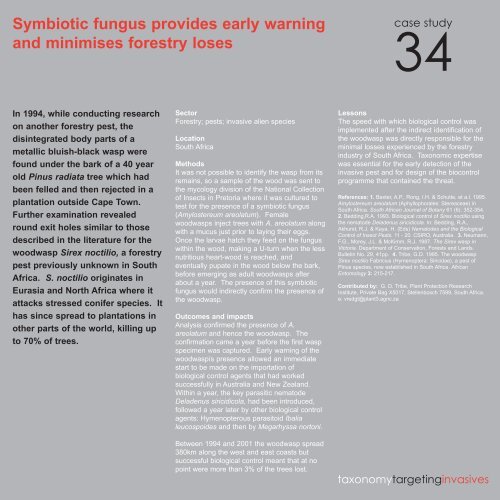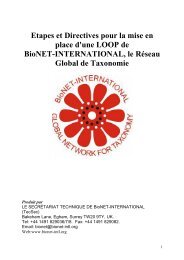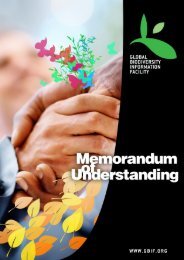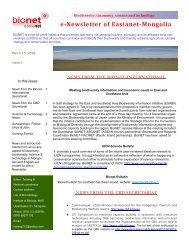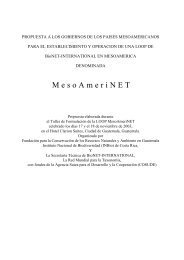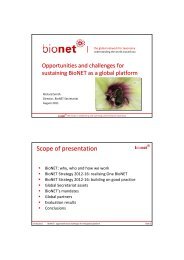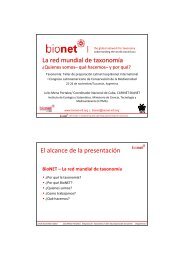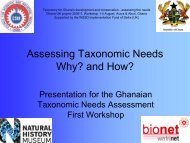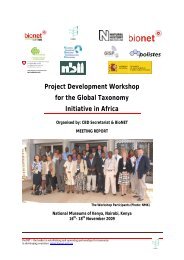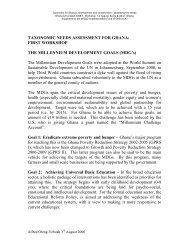Bio cover - BioNET
Bio cover - BioNET
Bio cover - BioNET
You also want an ePaper? Increase the reach of your titles
YUMPU automatically turns print PDFs into web optimized ePapers that Google loves.
Symbiotic fungus provides early warningand minimises forestry losescase study34In 1994, while conducting researchon another forestry pest, thedisintegrated body parts of ametallic bluish-black wasp werefound under the bark of a 40 yearold Pinus radiata tree which hadbeen felled and then rejected in aplantation outside Cape Town.Further examination revealedround exit holes similar to thosedescribed in the literature for thewoodwasp Sirex noctilio, a forestrypest previously unknown in SouthAfrica. S. noctilio originates inEurasia and North Africa where itattacks stressed conifer species. Ithas since spread to plantations inother parts of the world, killing upto 70% of trees.SectorForestry; pests; invasive alien speciesLocationSouth AfricaMethodsIt was not possible to identify the wasp from itsremains, so a sample of the wood was sent tothe mycology division of the National Collectionof Insects in Pretoria where it was cultured totest for the presence of a symbiotic fungus(Amylostereum areolatum). Femalewoodwasps inject trees with A. areolatum alongwith a mucus just prior to laying their eggs.Once the larvae hatch they feed on the funguswithin the wood, making a U-turn when the lessnutritious heart-wood is reached, andeventually pupate in the wood below the bark,before emerging as adult woodwasps afterabout a year. The presence of this symbioticfungus would indirectly confirm the presence ofthe woodwasp.Outcomes and impactsAnalysis confirmed the presence of A.areolatum and hence the woodwasp. Theconfirmation came a year before the first waspspecimen was captured. Early warning of thewoodwaspís presence allowed an immediatestart to be made on the importation ofbiological control agents that had workedsuccessfully in Australia and New Zealand.Within a year, the key parasitic nematodeDeladenus siricidicola, had been introduced,followed a year later by other biological controlagents: Hymenopterous parasitoid Ibalialeucospoides and then by Megarhyssa nortoni.Between 1994 and 2001 the woodwasp spread380km along the west and east coasts butsuccessful biological control meant that at nopoint were more than 3% of the trees lost.LessonsThe speed with which biological control wasimplemented after the indirect identification ofthe woodwasp was directly responsible for theminimal losses experienced by the forestryindustry of South Africa. Taxonomic expertisewas essential for the early detection of theinvasive pest and for design of the biocontrolprogramme that contained the threat.References: 1. Baxter, A.P., Rong, I.H. & Schutte, et a.l. 1995.Amylostereum areolatum (Aphyllophorales: Stereaceae) inSouth Africa. South African Journal of Botany 61 (6): 352-354.2. Bedding,R.A. 1993. <strong>Bio</strong>logical control of Sirex noctilio usingthe nematode Deladenus siricidicola. In: Bedding, R.A.,Akhurst, R.J. & Kaya, H. (Eds) Nematodes and the <strong>Bio</strong>logicalControl of Insect Pests. 11 - 20. CSIRO, Australia. 3. Neumann,F.G., Morey, J.L. & McKimm, R.J. 1987. The Sirex wasp inVictoria. Department of Conservation, Forests and Lands.Bulletin No. 29, 41pp. 4. Tribe, G.D. 1995. The woodwaspSirex noctilio Fabricius (Hymenoptera: Siricidae), a pest ofPinus species, now established in South Africa. AfricanEntomology 3: 215-217.Contributed by: G. D. Tribe, Plant Protection ResearchInstitute, Private Bag X5017, Stellenbosch 7599, South Africa.e: vredgt@plant3.agric.zataxonomytargetinginvasives


